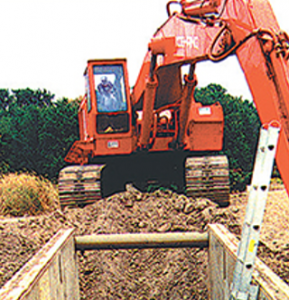Event Details
April 27, 2021 — April 29, 2021
This is a 3 day virtual event, 2 hours each day. The webinar will begin each day at 8:00 am and end at 10:00 am.
All times are Central Time Zone.
Details to access the Webex webinar will be emailed at a later date.
Event Contact
Overview
The workshop explains the hazards of excavation and trenching, how accidents happen, and how worker protective measures should be applied. It’s a great way to inform new employees of safety protocol or to update more experienced employees on new safety information.
The workshop covers:
- Critical definitions and context for excavation safety
- Soils analysis: testing local soils and handling testing equipment
- Shoring options: a walk-through of all the basic systems—sloping, shoring, and shielding
The workshop also provides assurance that all relevant duties of a competent person at an excavation site will be fully covered and explained. However, the employer has responsibility and authority to actually designate a worker as a Competent Person. The course covers the requirements of 29 CFR Part 1926, Subpart P-Excavations, of the OSHA standards for the construction industry and essential material on the similarities and differences between General Industry Confined Space and the new Construction Confined Space standard Subpart AA.
Who Should Attend?
- All crew members who are involved in excavation will find this workshop beneficial.
- Supervisors responsible for trenching operations; foremen; safety coordinators; and backhoe, dragline, and excavator operators are especially encouraged to attend.
- City/County engineers or administrators who are responsible for employee safety and have trenching and excavation work done in their jurisdiction will also find the material in this course valuable.
Highly Qualified Instructor
Wendell Wood comes highly recommended by past excavation safety workshop instructor Jack Mickle. Wood served as co-chairman of the National Utility Contractors Association (NUCA) Safety Committee, formed MMJ Consulting as a training organization, and in partnership with Jack Mickle participated in the training of compliance officers for OSHA’s training division. He served as the first president of the Trench Shoring and Shielding Association (TSSA) and continues as a consultant to TSSA, as a consultant for Pacific Shoring, Inc., and as past vice-chairman of ANSI 10.12 Subcommittee: Excavation.
Participants must be present for all 3 days to receive their certificate and wallet card.
Tentative Agenda
April 27, 2021
- First Hour—Scope and Foundational Concepts to the standard
- Base principle—always potential for a Cave-in
- What is a cave in—how much soil to fall to constitute a cave-in
- What are the two types of soil—granular and cohesive
- What is an accident—why a cave-in is not considered an accident
- Introduction to Protective Systems: What is a protective system—in example given, what is proper slope for C Type Soil
- Concept of Competent Person
- Second Hour—Hazard Recognition Primer/General Requirements
- History of the standard/OSHA
- General Duty Clause
- Key definitions—Excavation/Trench/Cave-in/Competent Person/Role of the Engineer
- General Requirements—
- Surface Encumbrance
- Underground Installations
- Access and Egress
- High Visibility
- Under Loads
- Loading trucks
- Mobile Equipment Adjacent to Excavation/Trench
April 28, 2021
- First Hour—Complete General Requirements—Review Prior Day Briefly
- Hazardous Atmospheres
- Hazards associated with water/water accumulation
- Hazards with adjacent structures
- Hazards near the excavation/trench: Loose Soils/Spoil Pile, materials/equipment
- Inspections: When, Where, What, How, Why and how documented
- Hazards associated with falls—excavations/trenches six feet or deeper
- Second Hour—
- Soils Analysis—Visual and Manual Testing
- Introduction to Protective Systems
April 29, 2021
- First Hour—
- Appendix B: Sloping and benching—four options
- Alternatives to Sloping:—four options
- Appendix C: Wood and Timber
- Appendix D: Hydraulic Shoring—limitations of this Appendix
- Tabulated Data—Active and Passive equipment
- Have it your way protective systems
- Second Hour—
- Shields per OSHA and Manufacturer’s Tabulated Data
- Assessment—
- Conclusion
